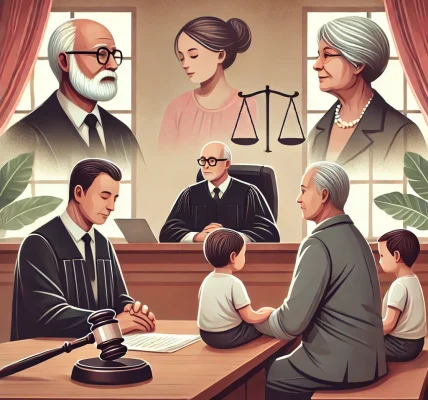Introduction
In family law, restraining orders play a crucial role in protecting individuals from harassment, abuse, or potential harm. Whether it’s a case of domestic violence, stalking, or threats, a restraining order offers legal protection by restricting the accused person’s ability to contact or approach the victim. Understanding the types, process, and legal implications of obtaining a restraining order is essential for anyone seeking safety and security.
This guide explains restraining orders, their legal aspects, and how to obtain one while ensuring compliance with the law.
What is a Restraining Order?
A restraining order, also known as a protective order, is a legal directive issued by a court that prohibits an individual from engaging in specific activities that may cause harm or distress to another person. These activities may include physical abuse, threats, stalking, or any form of harassment.
Restraining orders are commonly used in family law cases, particularly in situations involving:
- Domestic violence
- Child abuse or neglect
- Threats from an ex-spouse or partner
- Harassment or stalking
- Situations where an individual feels endangered by a family member
Types of Restraining Orders
There are different types of restraining orders depending on the circumstances and the level of protection required:
1. Emergency Restraining Order (ERO)
- Issued by law enforcement or a judge in urgent situations.
- Typically lasts for a short period (e.g., 24-72 hours).
- Allows victims immediate protection before a formal court hearing.
2. Temporary Restraining Order (TRO)
- Provides short-term protection (usually 14-21 days) until a full court hearing is conducted.
- Can be issued without the accused being present in court.
- Often used in cases of domestic violence or threats.
3. Permanent Restraining Order
- Issued after a full hearing where both parties present their case.
- Can last for several months to several years, depending on the severity of the case.
- May include provisions such as no-contact orders and stay-away orders.
4. Domestic Violence Restraining Order (DVRO)
- Specifically for victims of domestic abuse, including spouses, ex-spouses, or cohabitants.
- Includes restrictions on physical proximity and communication.
5. Child Protective Restraining Order
- Issued to protect a child from abuse or neglect.
- Can be requested by a parent, guardian, or child welfare agency.
6. Workplace Harassment Restraining Order
- Used in cases where a colleague or employer is harassing an employee.
- Ensures safety within professional environments.
When Should You Get a Restraining Order?
A restraining order may be necessary in the following situations:
- Domestic violence: If a spouse, partner, or family member physically or emotionally abuses you.
- Threats or stalking: If someone continuously harasses or follows you, causing fear for your safety.
- Child abuse: If you suspect a child is being abused by a parent or guardian.
- Harassment: If an individual is sending threatening messages, calling excessively, or engaging in intimidating behavior.
- Sexual assault cases: If you have been assaulted or feel at risk of harm.
Legal Process for Obtaining a Restraining Order
Obtaining a restraining order involves several steps, which vary depending on jurisdiction. Here is a general step-by-step process:
Step 1: Gather Evidence
- Collect proof of harassment, threats, or abuse, such as:
- Text messages, emails, or phone call logs
- Medical records (if applicable)
- Police reports (if a complaint has been filed)
- Eyewitness statements
Step 2: File a Petition
- Visit your local family court and request the necessary restraining order forms.
- Provide detailed information about the threats or abuse.
- Submit the petition along with any supporting evidence.
Step 3: Court Review & Temporary Order Issuance
- A judge will review the application and decide whether to grant a Temporary Restraining Order (TRO).
- If approved, the temporary order goes into effect immediately.
- The accused (respondent) is served with the order and informed about the court hearing date.
Step 4: Attend a Court Hearing
- A hearing is scheduled within a few weeks.
- Both the petitioner (victim) and the respondent (accused) have an opportunity to present their case.
- Legal representation is recommended, but not always required.
Step 5: Issuance of a Permanent Restraining Order
- If the judge determines that continued protection is necessary, a permanent restraining order is issued.
- The duration varies depending on the severity of the case (e.g., one year, three years, or indefinitely).
- Violation of the restraining order can lead to legal consequences, including fines and jail time.
Rights & Responsibilities Under a Restraining Order
Once a restraining order is in place, both parties must adhere to its conditions:
For the Petitioner (Protected Person)
- Keep a copy of the order at all times.
- Report any violations immediately to the police.
- Ensure that law enforcement and your employer are aware of the order.
For the Respondent (Restrained Person)
- Must comply with all restrictions stated in the order.
- Avoid any form of contact with the protected person.
- Seek legal assistance if there is a need to challenge or modify the order.
Consequences of Violating a Restraining Order
Violating a restraining order is a serious offense and may result in:
- Fines or penalties imposed by the court.
- Criminal charges, which could lead to jail time.
- Extension of the restraining order or additional legal restrictions.
Modifying or Terminating a Restraining Order
In some cases, a restraining order may need to be modified or lifted. Either party can:
- Request a court hearing to present reasons for modification.
- Provide evidence demonstrating why the order should be changed or revoked.
- Follow legal procedures rather than violating the order, as breaches can lead to penalties.
Conclusion
Restraining orders are a vital legal tool in family law, offering protection to individuals facing threats, harassment, or abuse. Knowing when and how to obtain a restraining order ensures that individuals take the right steps to secure their safety. If you find yourself in a situation requiring legal protection, consulting with a family law attorney is highly recommended to navigate the legal process effectively.




